Bogucki P., Crabtree P. Ancient Europe 8000 B.C.-A.D. 1000: Encyclopedia of the Barbarian World. Volume 2
Подождите немного. Документ загружается.

semiflexed burial: Deposition of a body with the
legs pulled only partially toward the torso. The
body also is often placed on its side.
seriation: A chronological ordering of artifacts ac-
cording to changes in frequency, form, and dec-
oration.
settlement pattern: A characterization of the way
in which habitations and other structures are ar-
ranged across a landscape, including such vari-
ables as form, size, distribution, and density.
shell midden: An accumulation of refuse from the
collection and consumption of shellfish. Burials,
tools, and other types of refuse are often includ-
ed.
sherd: A fragment of pottery or worked clay. Also
known as “shard” or “potsherd.”
shield boss: An attachment to the center of a shield,
often dome shaped or pointed.
shifting cultivation: An agricultural system in
which areas are cleared of native vegetation, cul-
tivated, and then left unused for a period of
time to replenish the soil with nutrients. See also
bush fallow cultivation and swidden.
ship setting: A Viking period Scandinavian burial
monument characterized by an oval arrange-
ment of stones in the outline of a boat, usually
with taller stones representing stern and bow
posts.
site: Any location where artifacts, ecofacts, or ar-
chaeological features are found. Types of sites
range from a scatter of a few flints to an entire
city.
situla (pl. situlae): A bucket-shaped vessel, usually
of pottery or bronze.
slag: Refuse from smelting metal. Usually a glassy,
porous, and fused material.
sling stone: A rock collected for use as a missile and
thrown with a sling. Often found as caches on
the perimeter of defended settlements.
slip: Viscous material applied to the surface of pot-
tery before firing. Composed of clay, water, and
often colorants or other additives.
smelting/smelted: The process of refining ore in
a furnace.
solidus: A Roman gold coin.
sounding: A test pit dug through the layers of a site
to allow for preliminary investigation of a site’s
stratigraphy and underlying features.
souterrains: A subterranean chamber constructed
from stone. Common in Ireland, western Brit-
ain, and Scotland.
spectrographic analysis: A technique for identify-
ing the combination of elements in an object.
Often an object possesses a unique combination
of trace elements that allows archaeologists to
define its origin. The presence of trace elements
is identified by measuring the wavelengths of ra-
diation emitted from samples.
spindle whorls: An implement used in spinning
thread and yarn to maintain the momentum of
a rotating spindle. Usually made from stone or
clay in the form of a disk or sphere with a hole
in the middle.
stable carbon isotopes: Forms of carbon that do
not naturally undergo radioactive decay. Com-
monly used in studies of provenance and diet.
stater: A Greek coin of gold or silver.
steatite: A relatively soft type of stone, well suited
to carving and working into vessels. Also known
as “soapstone.”
stela (pl. stelae): A stone pillar, usually with carving
and/or inscriptions.
stratigraphy: The layering of sediments into suc-
cessive strata or the analysis of the results of this
process. A cornerstone of archaeological inter-
pretation is that, barring evidence of subse-
quent disturbance, lower strata were formed in
an earlier period than higher strata.
strontium isotopes: Forms of a mineral compo-
nent of bone that are absorbed from the envi-
ronment through diet and other means. Used
to reconstruct diet.
Subatlantic climatic period: A subdivision of the
Holocene epoch in northern Europe that be-
gins c. 800
B.C. and extends to the present. As
with the Subboreal, cooler temperatures than
are found in the Atlantic characterize the Sub-
atlantic period. See also Preboreal, Boreal, At-
lantic, and Subboreal climatic periods.
Subboreal climatic period: A subdivision of the
Holocene epoch in northern Europe that began
GLOSSARY
612
ANCIENT EUROPE
c. 3800 B.C. and ended c. 800 B.C. Cooler tem-
peratures than are found in the Atlantic charac-
terize the period. See also Preboreal, Boreal, At-
lantic, and Subatlantic climatic periods.
sub-Roman: A term for groups or territories with-
out an Anglo-Saxon material culture in the peri-
od following Roman rule in Britain. Used in
preference to the term “post-Roman” because
many characteristics of Roman culture endured
into the medieval period. Also used in prefer-
ence to “British” or “Celtic” because “sub-
Roman” is less ethnically specific and charged
by historical debate.
successor states: Political units that emerge after
the collapse of an empire or other expansive and
centralized organization.
supine: Lying face up with limbs extended.
survey: The process of investigating and recording
the archaeological assets of an area, usually
without extensive excavation.
swidden: An agricultural field created by cutting,
burning, or otherwise removing wild vegeta-
tion. Usually part of a shifting cultivation sys-
tem.
taiga: See boreal forest.
taphonomy/taphonomic: The study of the pro-
cesses affecting the remains of organisms, par-
ticularly bones, between death and final embed-
ding in the ground. Relevant processes include
gnawing by scavengers and dispersal by flowing
water.
tell: A mound in the Near East or southeastern Eu-
rope created by building successive settlements,
usually from mud bricks, on the same location.
Synonymous terms include “tepe” and
“hüyük.”
temper/tempered: 1. Material, such as coarse sand
or ground shell, added to clay in the process of
making pottery. The additive makes clay more
workable and reduces cracking during firing. 2.
The process of hardening metal, particularly
iron, by repeated cooling and heating.
tephra/tephrochronology: Particulate material
ejected during volcanic eruptions. When it be-
comes incorporated into sediment in a land-
scape, tephra can be used to date the formation
of that sediment. For relative dating, in areas
where the sequence of eruptions is known, it is
possible to correlate the stratigraphy of samples
from different areas that possess layers of
tephra. Tephra is also useful for absolute dating
because the unique form of tephra from some
individual eruptions is known.
terp (pl. terpen): A mound on the coastal plain of
the Netherlands and Germany created to raise
a settlement above wet ground.
terra sigillata: A type of fine mass-produced Medi-
terranean tableware pottery. Made with a glossy
red slip applied to its surface. Produced and ex-
ported across Europe from the first century
B.C.
through the second century
A.D.
terremare: An Italian term for a mound created
during the Bronze Age by successive settle-
ments built on the same location.
tholos: A stone chamber capped by a corbeled vault.
Three Age System: The chronology running from
the Stone Age to the Bronze Age to the Iron
Age. Developed early in the nineteenth century
on the basis of the sequence of change in prehis-
toric tool technology. The defining characteris-
tics of each age have been refined and elaborat-
ed considerably since then. For example, the
Neolithic is now defined primarily by the use of
domestic animals and plants.
toponym: Place name.
torc: A neck ring, often of gold or bronze. Also
spelled “torque.”
transgression: The flooding of land, usually due to
a rise in sea level.
transhumance: The movement of livestock season-
ally between upland and lowland pasture.
trapeze: A microlith shaped into the form of a trap-
ezoid (two parallel sides and two convergent
sides).
trefoil: A decorative motif in the shape of a trifoliate
leaf, such as a clover.
tremissis: A Merovingian gold coin.
trepanation: Medical procedure involving the re-
moval of a piece of a living human’s skull. Some
skulls bear traces of the survival of multiple tre-
panations.
GLOSSARY
613
ANCIENT EUROPE
trilithon: A megalithic monument composed of
two upright stone slabs supporting a capstone
slab, most famously at Stonehenge.
tufa: Rock formed of calcium carbonate deposited
from ground or surface water, as in the material
from which a stalagmite is formed. Used as an
architectural material. Archaeologists also ana-
lyze samples for data about past climates. Also
known as “travertine.”
tuff: A geological layer formed of volcanic ash and
other material. Also rock composed of com-
pacted or fused volcanic material.
tumulus: A mound constructed from earth or
stone, generally circular and containing a burial.
Also known as a “barrow” or “kurgan.”
tuyere: A nozzle used to direct air from a bellows
into a metalworking furnace. Often the only
surviving evidence of metalworking.
type site: A find spot that gives its name to, or is
used as an exemplar of, a type of settlement, an
artifact, or an archaeological culture, usually be-
cause it is the location of the first discovery or
is the most representative example.
typology: An ordering of objects into categories,
usually based on form and decoration.
urbanism: Characteristic of an urban center and the
associated ways of life.
urnfield: A cemetery of cremations placed in urns
and buried in pits. A burial rite associated with
the Late Bronze Age.
Viereckschanze (pl. Viereckschanzen): A rectilinear
enclosure defined by a bank and ditch. The fre-
quent presence within the enclosure of pits and
wells containing votive deposits fosters inter-
pretation of these monuments as ritual enclo-
sures, although some argue that they were habi-
tations as well.
viticulture: The cultivation of grapes.
vitrified fort: A hillfort with an exterior wall face
that is smoothed and fused together by heat and
wind.
wattle and daub: A technique for constructing
walls. Wattles are thin rods or tree shoots woven
between stakes planted in the ground. Daub is
mud, dung, or another type of plaster spread
over the wattling.
wave-of-advance model: A theory that postulates
a steady rate of spread, usually of cultural traits,
across a landscape over time. Principally associ-
ated with the demic diffusion model for agricul-
ture in Europe.
weir: A barrier set in water to channel fish or other
quarry into a trap or a fence in tidal areas over
which fish can swim in at high tide but cannot
swim out at low tide and thus are trapped on the
tidal flat.
withe: A slender branch or shoot.
wurt (pl. wurten): See terp.
zooarchaeology: The study of animal remains from
archaeological sites.
zoomorphic: In the shape of or possessing charac-
teristics of an animal.
GLOSSARY
614
ANCIENT EUROPE
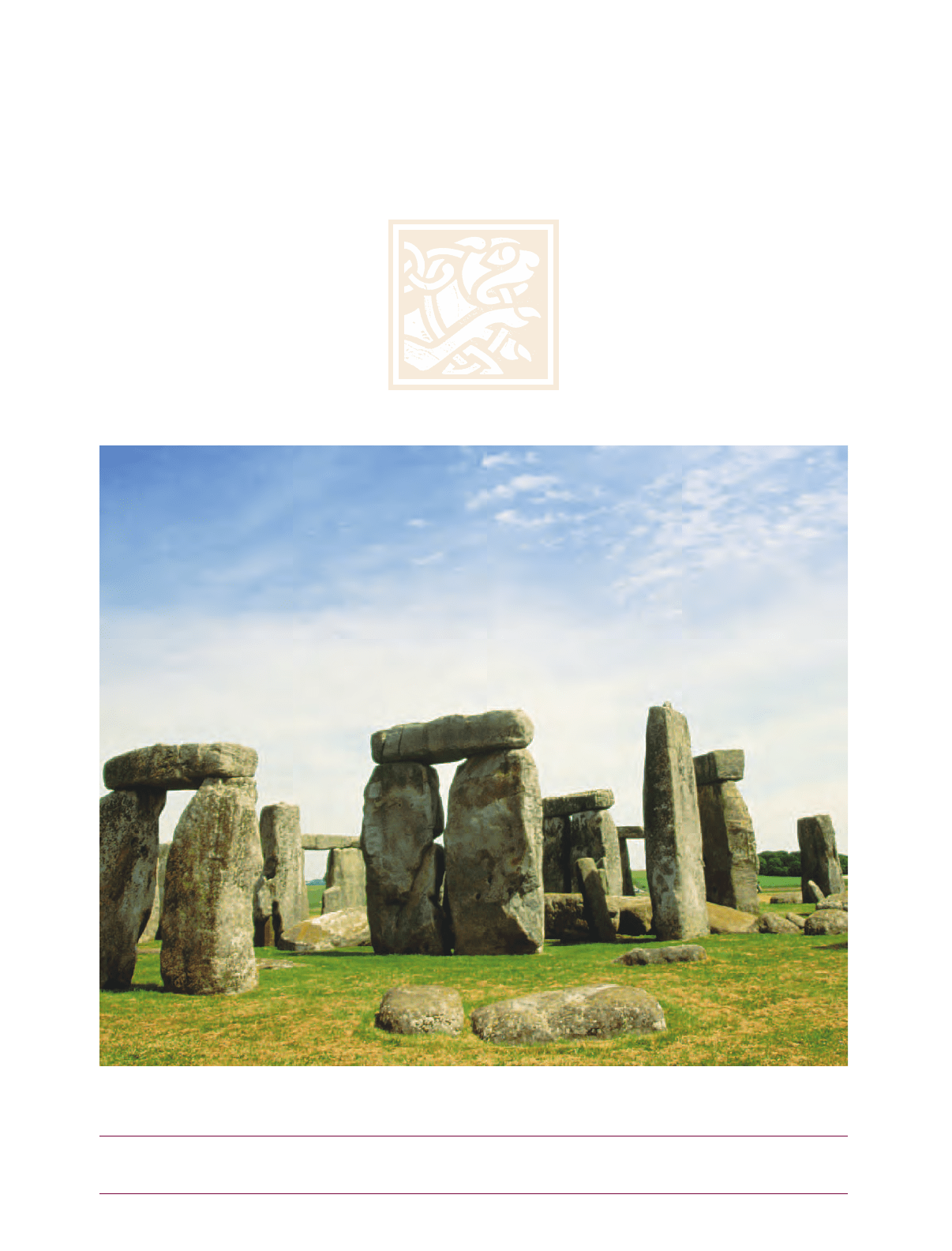
A
Stonehenge The ritual monument of Stonehenge as it appears today. First built during the Neolithic period, Stonehenge
experienced several construction phases before being abandoned in the middle of the second millennium B.C.© BOB KRIST/CORBIS.
REPRODUCED BY PERMISSION.
AEv2-ci pgs 10,7,03hi.qx4 10/21/03 11:15 AM Page 1
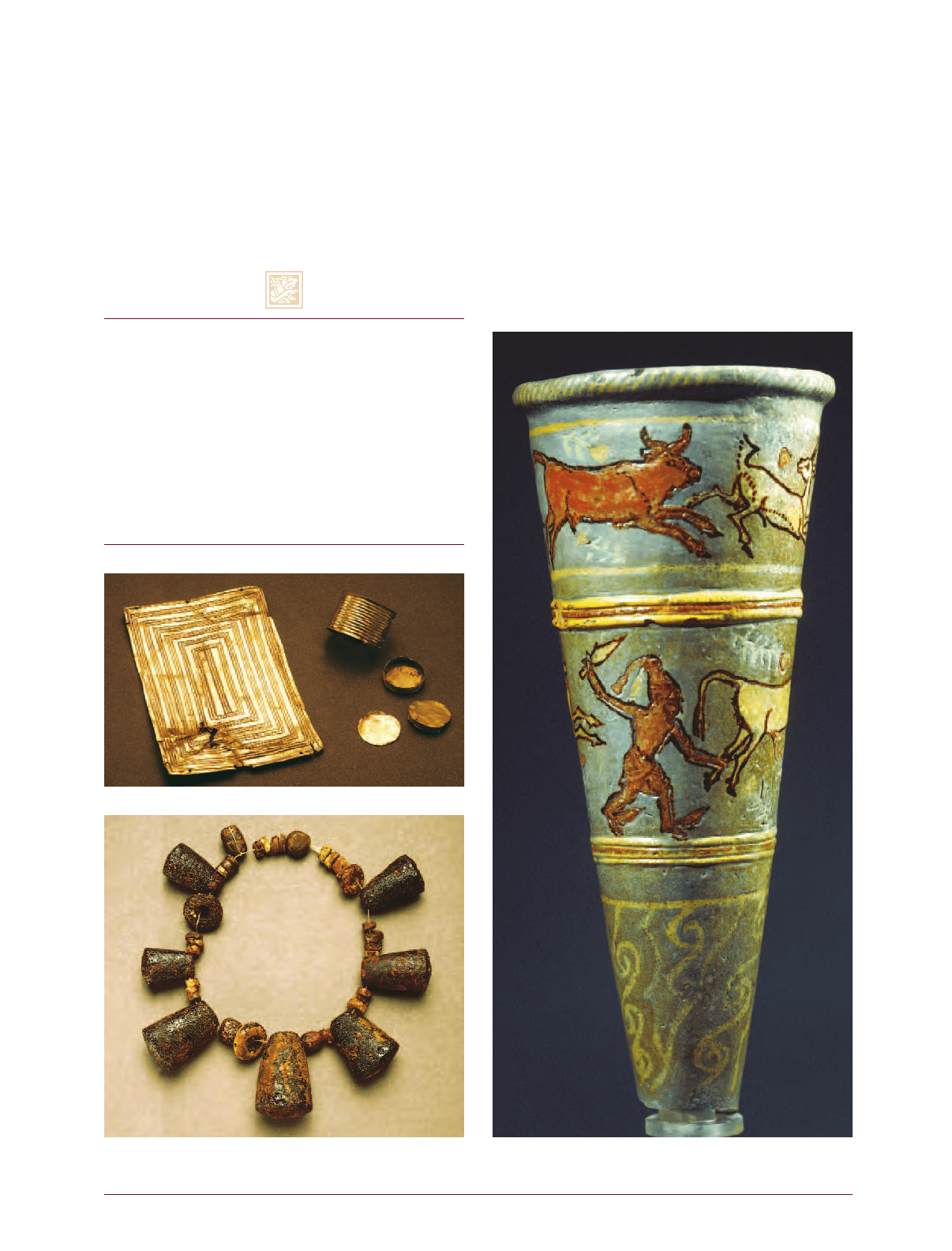
RIGHT: Bronze Age Cyprus A funnel-shaped faience
“Rhyton” (ceremonial vessel) of the thirteenth century B.C.,
from the excavations at Kition, Cyprus. The surface of the
vessel is covered with a layer of blue enamel and is divided
into three horizontal bands, with the design elements painted
in black, yellow, and green, and inlaid with red enamel.
© GIANNI DAGLI ORTI/CORBIS. REPRODUCED BY PERMISSION.
LEFT: Bronze Age Britain and Ireland Goldwork and amber
necklace from the grave group at Little Cressingham, Norfolk,
c. 1800–1500 B.C. These goods were acquired by exchange
and indicate the wealth of the deceased. © THE TRUSTEES OF THE
NATIONAL MUSEUMS OF SCOTLAND. REPRODUCED BY PERMISSION.
AEv2-ci pgs 10,7,03hi.qx4 10/21/03 11:15 AM Page 2
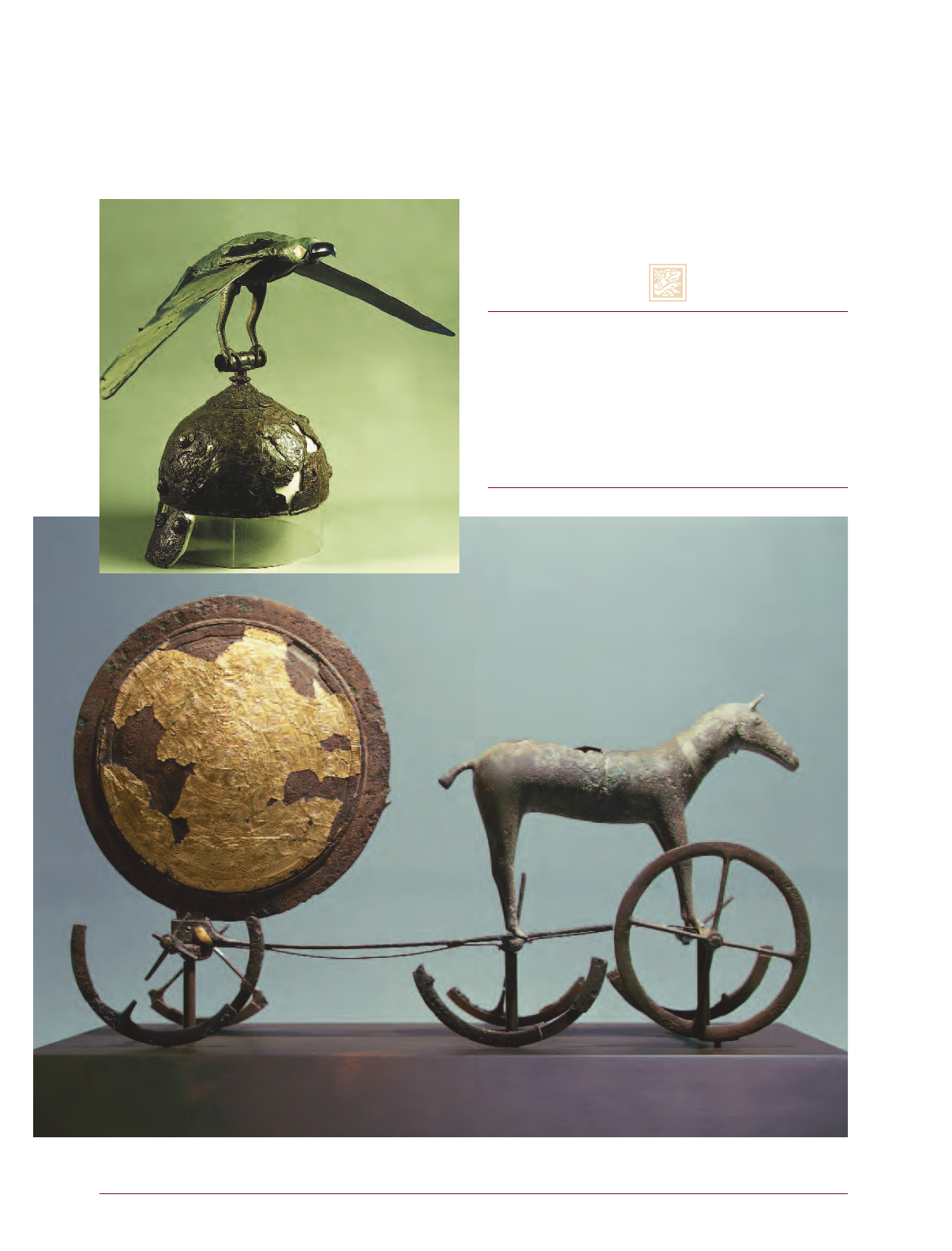
TOP LEFT: Celts Celtic helmet surmounted by vulture, fourth
century B.C.THE ART ARCHIVE/NATIONAL MUSEUM BUCHAREST/DAGLI
ORTI. REPRODUCED BY PERMISSION.
BELOW: Bronze Age Scandinavia The “sun chariot” of
bronze found in a bog at Trundholm in northwestern Zealand,
Denmark, dates to c. 1500 B.C. The horse and the spiral-
decorated sun disk are situated on a wagon, probably
together forming a cult device. © ARCHIVO ICONOGRAFICO,
S.A./CORBIS. REPRODUCED BY PERMISSION.
AEv2-ci pgs 10,7,03hi.qx4 10/21/03 11:15 AM Page 3
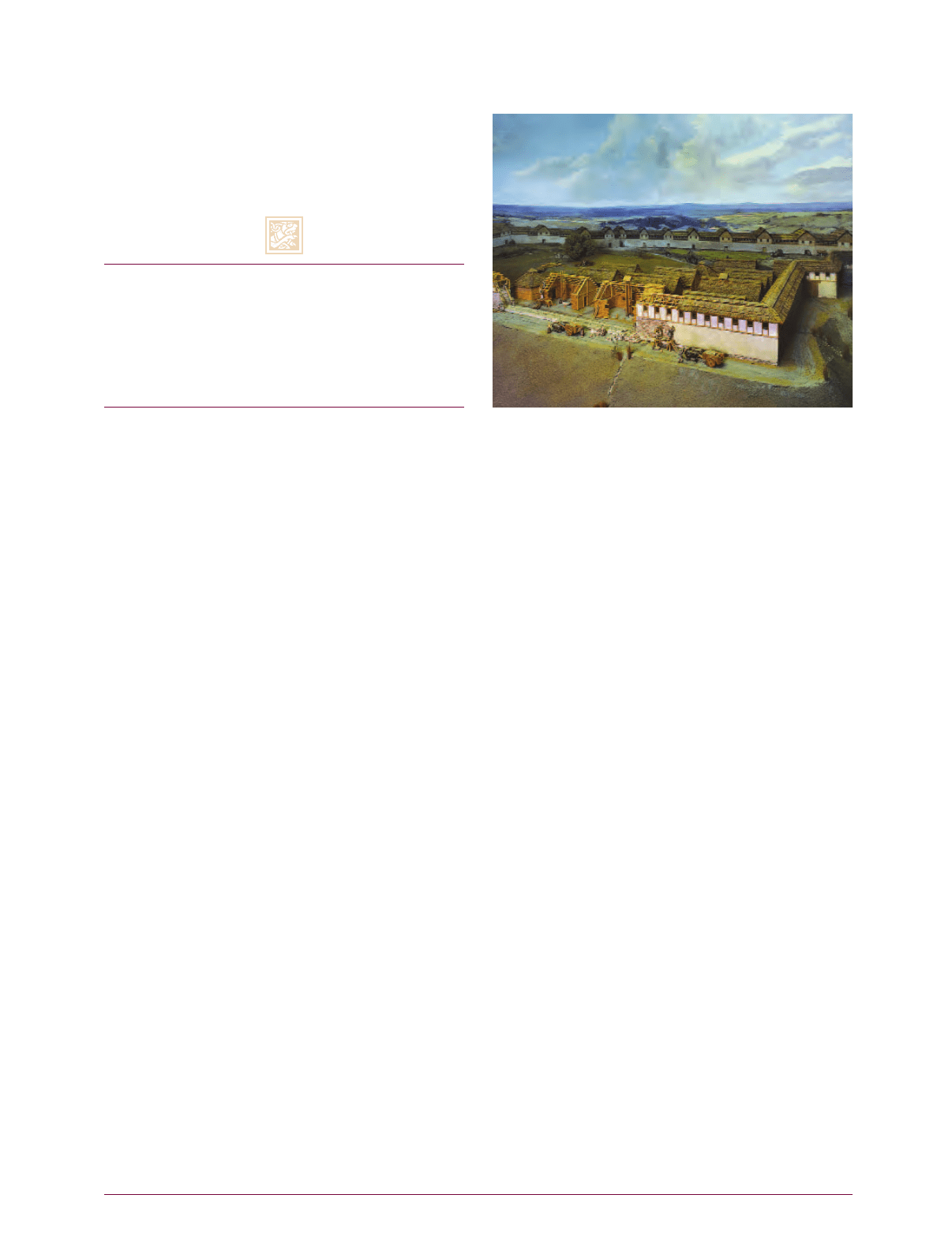
TOP RIGHT: The Heuneburg Model of the Heuneburg,
Heuneburg Museum. This Early Iron Age hillfort housed
thousands of people, c. 600–450 B.C.ROSE HAJDU, FOTOGRAFIE,
STUTTGART. REPRODUCED BY PERMISSION.
AEv2-ci pgs 10,7,03hi.qx4 10/21/03 11:15 AM Page 4
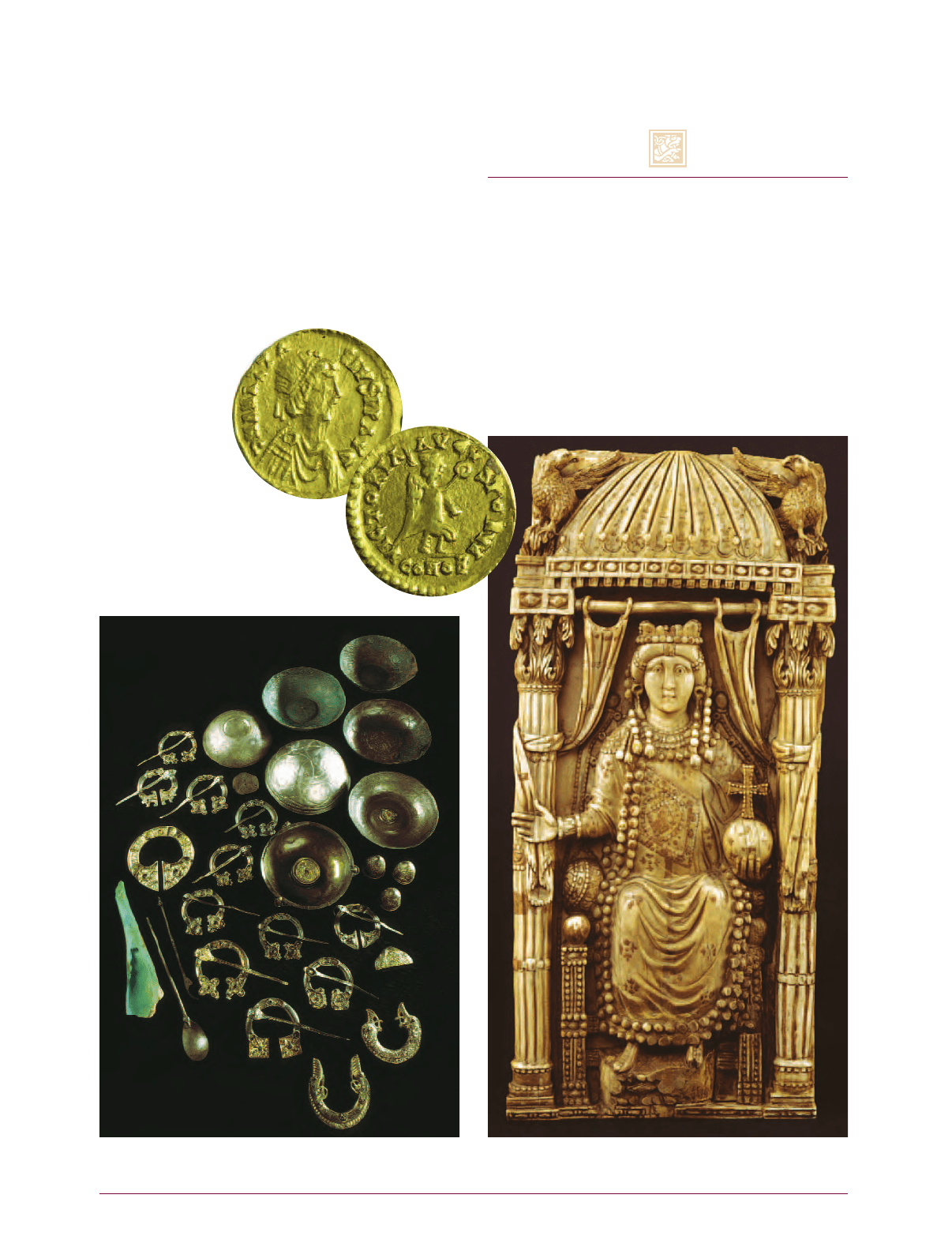
TOP LEFT: Coinage of the Early Middle Ages Visigothic
pseudo-imperial gold tremissis, c. seventh century A.D.THE
AMERICAN NUMISMATIC SOCIETY, NEW YORK. REPRODUCED BY
PERMISSION.
BELOW LEFT: Migration Period Peoples: Picts Pictish silver
hoard from St. Ninian’s Isle, Shetland. This hoard of monastic
silver is from c. A.D. 800. © THE TRUSTEES OF THE NATIONAL
MUSEUMS OF SCOTLAND. REPRODUCED BY PERMISSION.
BELOW RIGHT: Migration Period Peoples: Ostrogoths Ivory
of Amalasuntha, queen of the Ostrogoths, c. A.D. 530.
Amalasuntha’s short reign ended with her murder in A.D. 535.
KUNSTHISTORISCHES MUSEUM, WIEN. REPRODUCED BY PERMISSION.
AEv2-ci pgs 10,7,03hi.qx4 10/21/03 11:15 AM Page 5
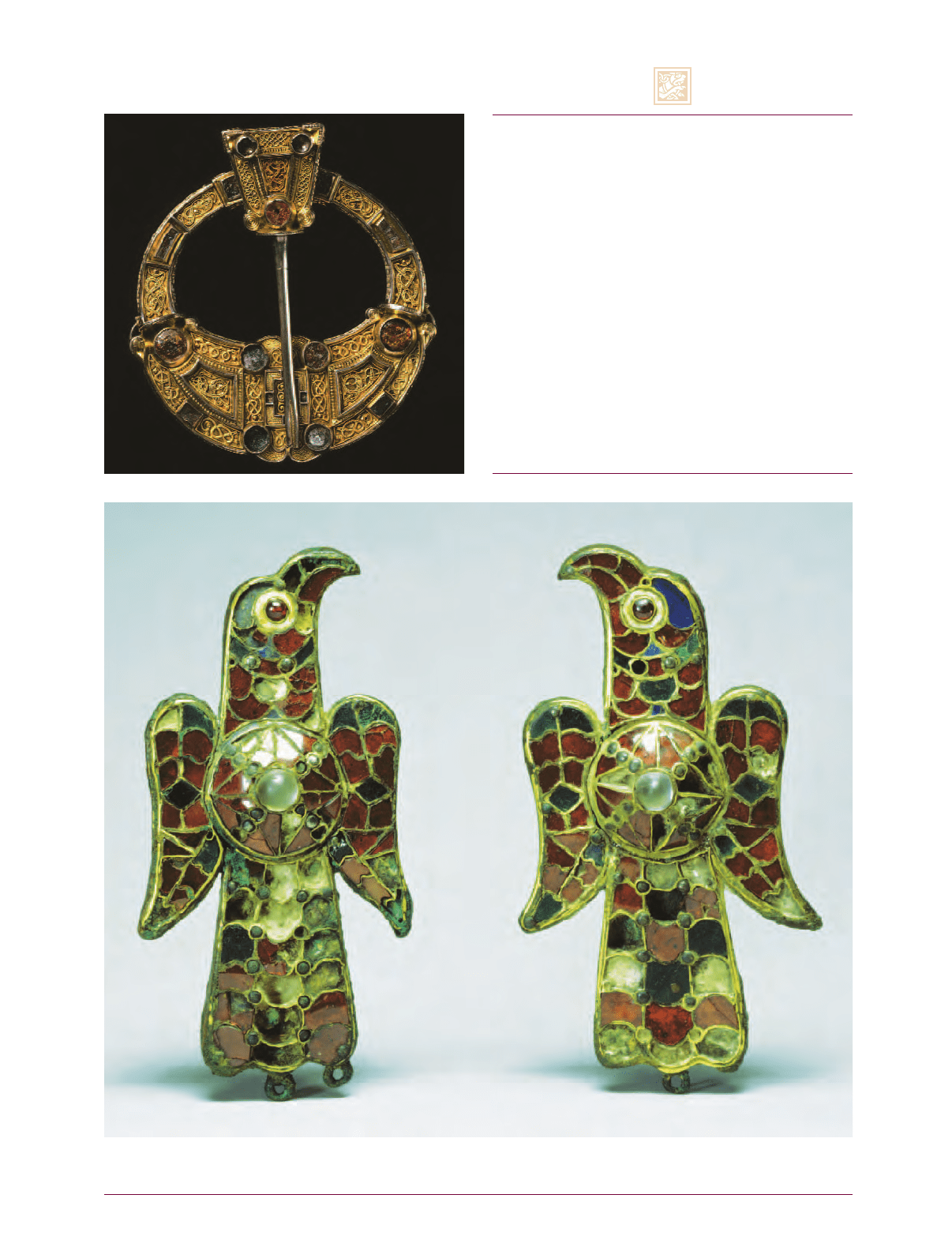
TOP LEFT: Dark Age/Early Medieval Scotland The
Hunterston brooch, c. A.D. 700, was found in the early
nineteenth century in Ayrshire, Scotland, and named after the
estate on which it was found. It is one of the finest examples
of Celtic goldsmiths’ art. © THE TRUSTEES OF THE NATIONAL
MUSEUM OF SCOTLAND. REPRODUCED BY PERMISSION.
BELOW: Jewelry Pair of Ostrogothic eagle-shaped fibulae: gilt
bronze with cloisonné inlay of garnets, green stones or glass,
blue glass, crystal, amethyst, and meerschaum, early sixth
century A.D.THE WALTERS ART MUSEUM, BALTIMORE. REPRODUCED BY
PERMISSION.
OPPOSITE PAGE, TOP LEFT: Sutton Hoo Anglo-Saxon clasp from
Sutton Hoo, England: cloisonné garnet, millefiori, and blue
glass inlay in gold with filigree, early seventh century A.D.© THE
BRITISH MUSEUM. REPRODUCED BY PERMISSION.
OPPOSITE PAGE: Clothing and Textiles Male and female
costume during the Viking Age. ANDROMEDA OXFORD LTD.
REPRODUCED BY PERMISSION.
AEv2-ci pgs 10,7,03hi.qx4 10/21/03 11:15 AM Page 6
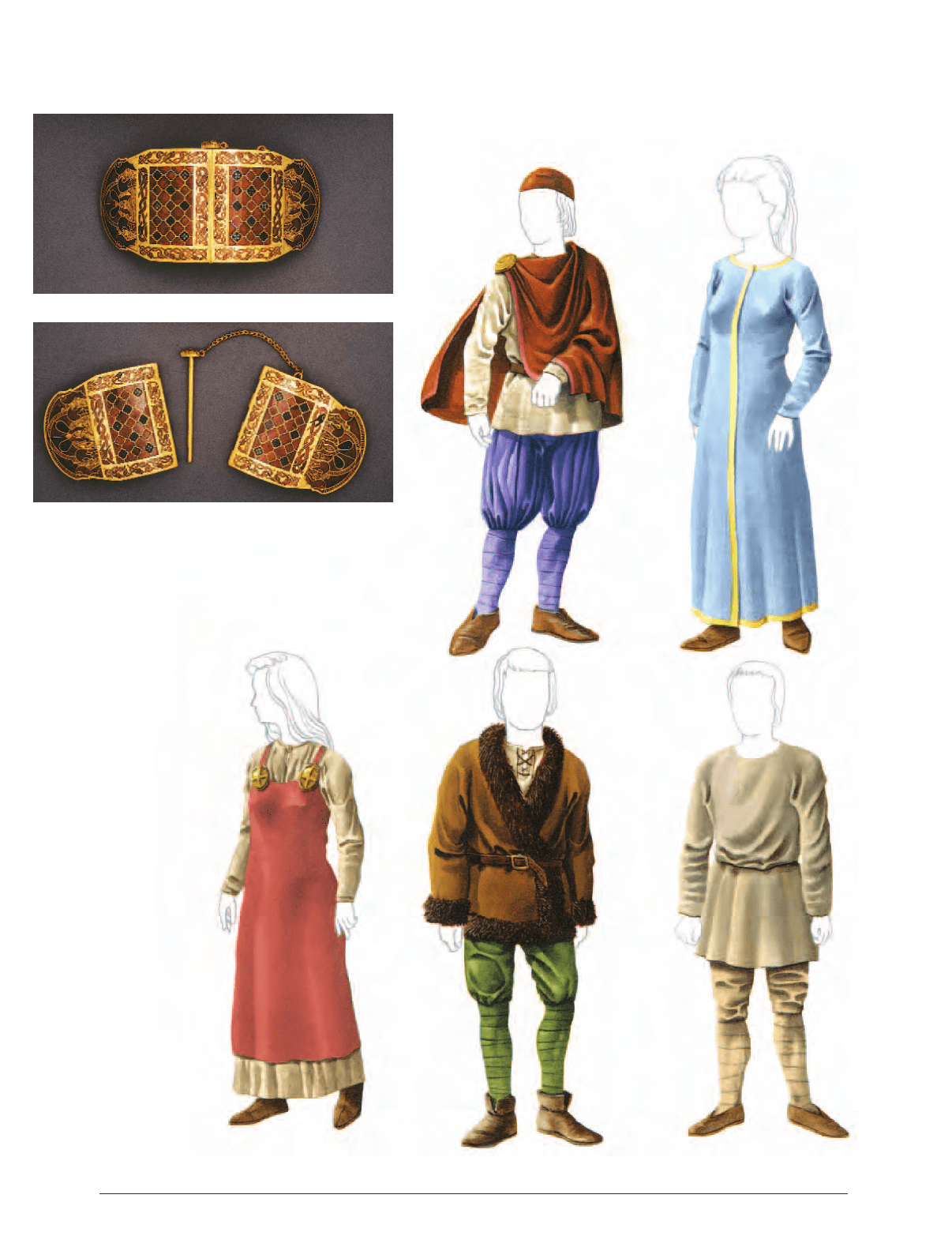
AEv2-ci pgs 10,7,03hi.qx4 10/21/03 11:15 AM Page 7
